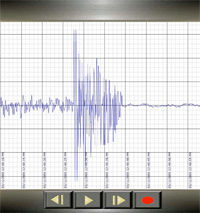RoomQuake
January 2nd, 2006 - April 1st, 2006
Categories: Applications, Education, Human Factors, Visualization

About
Roomquake is a distributed simulation of a series of earthquakes using PDAs as simulated (position-dependent) seismographs. Roomquake was designed to support students’ participation in authentic seismological practice: the interpretation of seismograms to determine the epicenter and magnitude of earthquakes.
Roomquake uses Embedded Phenomena, which is an emerging framework intended to support science inquiry in K-6 classrooms. The basic idea is to use simulation to map scientific phenomena into the physical space of classrooms.
Investigations employing Embedded Phenomena require students to observe, measure, and control the simulated phenomena. Typically, these phenomena are constructed to operate asynchronously with respect to the regular flow of instruction; things happen “when they happen,” The phenomena are designed to operate over extended periods (days, weeks, or months), sometimes because the phenomena themselves operate on that scale, and sometimes because they are temporally scaled to suit classroom constraints and learning needs.
Embedded Phenomena does not (necessarily) seek a 1-to-1 mapping between individuals and technology tools or affordances; access to affordances may be mediated by instructional and social goals and student capabilities and interests.